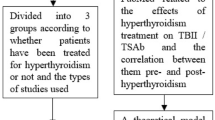Abstract
With evidence on the important role of glycosaminoglycans (GAG) in the pathogenesis of endocrine ophthalmopathy (EO) having accumulated, the present study focused on the biochemical assessment of plasma GAG content in 37 EO patients as compared to 20 controls. Glycosaminoglycans were isolated from plasma samples by protein elimination, dialysis, and precipitation with ethanol and cetylpyridinium chloride. Patients (9.71, 5.09, 15.09 mg/100 ml; median, 25th, 75th percentile) exhibited significantly (p=0.0021) higher plasma GAG levels than controls (4.6, 3.38, 6.8 mg/100 ml). Plasma GAG content was unrelated to age, sex, or antithyroid treatment. However, an even higher level of significance (p=0.0001) was reached when discriminating between untreated patients with EO of recent onset (14.16,10.35,15.51 mg/100 ml) and controls. By contrast, steroid therapy of EO led to values (3.82, 1.85, 6.52 mg/100 ml) indistinguishable from those of the controls. Further statistical analysis of the results, based on a specificity of 95% for the control group, revealed a sensitivity of 91 % for patients with untreated EO of recent onset, and a specificity of 100% for patients receiving steroid therapy. In comparison, plasma GAG content was determined in 8 untreated and in 6 treated EO patients by a second method already published. All untreated patients exhibited high GAG levels (median 2.23 mg/100 ml) whereas in treated EO patients normal plasma GAG values (0.17–0.34 mg/100 ml) were found. Follow-up determination of plasma GAG content in 7 patients undergoing steroid treatment unveiled a marked decrease of initially elevated values. These findings correlated well with clinical improvement of thyroid eye disease. Further studies involving a larger collective will permit a clinical evaluation of this parameter in the management of EO.
Similar content being viewed by others
References
Bartalena L., Marcocci C., Bogazzi F., Panicucci M., Lepri A., Pinchera A. Use of corticosteroids to prevent progression of Graves’ ophthalmopathy after radioiodine therapy for hyperthyroidism. N. Engl. J. Med. 320: 1349, 1989.
Prummel M.F., Wiersinga W.M., Mourits M.P., Koorneef L, Berghout A., van der Gaag R. Effect of abnormal thyroid function on the severity of Graves’ ophthalmopathy. Arch. Intern. Med. 150: 1098, 1990.
Campbell R.J. Immunology of Graves’ ophthalmopathy: retrobulbar histology and histochemistry. Acta Endocrinol. (Copenh.) 121(Suppl. 2): 9, 1989.
Smith T.J., Bahn R.S., Gorman C.A. Connective tissue, glycosaminoglycans, and diseases of the thyroid. Endocr. Rev. 70: 366, 1989
Smith T.J., Bahn R.S., Gorman C.A. Hormonal regulation of hyaluronate synthesis in cultured human fibroblasts: evidence for difference between retroocular and dermal fibroblasts. J. Clin. Endocrinol. Metab. 69: 1019, 1989.
Kahaly G., Stover C, Beyer J., Otto E. In vitro synthesis of glycosaminoglycans in endocrine ophthalmopathy. Acta Endocrinol. (Copenh.) 127: 397, 1992
Winand R.J., Wadeleux P.A. Glycosaminoglycan and orbital connective tissue autoantibodies. Acta EndocrInol. (Copenh.) 121(Suppl 2): 51, 1989.
Kahaly G., Schüler M., Sewell A.C, Bernhard G., Beyer J., Krause U. Urinary glycosaminoglycans in Graves’ ophthalmopathy. Clin. Endocrinol. (Oxf.) 33: 35, 1990.
Kahaly G., Stover C, Otto E., Beyer J., Schuler M. Glycosaminoglycans in thyroid-associated ophthalmopathy. Autoimmunity 13: 81, 1992.
Winand R.J. Increased urinary excretion of acidic mucopolysaccharide in exophthalmos. J. Clin. Invest. 47: 2563, 1968.
Classification of eye changes of Graves’ disease. Thyroid 2: 235, 1992.
Taniguchi N., Moriya N., Nanba I. Isolation and preliminary characterisation of glycosaminoglycans in human plasma. Clin. Chem. Acta 50: 319, 1974
Hilgers R.A. Distribution free confidence bounds for ROC-curves Meth. Inf. Med. 30: 150, 1991.
Bahn R.S., Heufelder A.E. Orbital connective tissue in endocrine ophthalmopathy. In: Kahaly G. (ed.) Endocrine Ophthalmopathy. Karger, Basel, 1993, p. 46.
Weetman A.P. Thyroid-associated eye disease: pathophysiology. Lancet 338: 25, 1991.
Heinegard D., Paulsson M. Structure and metabolism of proteoglycans. In: Piez K.A. Reddy A.H., (ed.) Extracellular matrix biochemistry. Elsevier, New York 1984, p. 277.
Kaplan D., Meyer K. The fate of injected mucopolysaccharides. Clin. Invest. 47: 743, 1962.
Poulsen J.H. Urine and tissue glycosaminoglycans and their interrelations. Dan. Med. Bull. 33: 75, 1986.
Bitter T., Siegenthaler P., Depreux T., Martin E. Excretion in the urine of aminoacridine precipitable polyuronides (acid mucopolysaccharides) in patients with rheumatoid arthritis. Ann. Rheum. Dis. 29: 427, 1979.
DiFerrante N., Rich C. The mucopolysaccharide of normal human urine. Clin. Chem. Acta 1: 519, 1956
Pennock C.A., Charles R.G., Stansbie D. Glycosaminoglycan fractions in normal human urine. Ann. Clin. Biochem. 12: 207, 1975.
Calatroni A., Donnelli P.V., DiFerrante N. The glycosaminoglycans of human plasma. J. Clin. Invest. 40: 332, 1969.
Staprans B., Fells ü. M. Isolation and characterization of glycosaminoglycans in human plasma. J. Clin. Invest. 76: 1984, 1985.
Wiersinga WM. Immunosuppression in endocrine ophthalmopathy: why and when? In: Kahaly G. (ed.) Endocrine Ophthalmopathy Karger, Basel, 1993. p. 120.
Just M., Kahaly G., Hilger H.P., Rosler H.P., Kutzner J., Beyer J., Thelen M. Graves’ophthalmopathy: role of MR imaging in radiation therapy. Radiology 179: 187, 1991.
Author information
Authors and Affiliations
Rights and permissions
About this article
Cite this article
Kahaly, G., Hansen, C., Beyer, J. et al. Plasma glycosaminoglycans in endocrine ophthalmopathy. J Endocrinol Invest 17, 45–50 (1994). https://doi.org/10.1007/BF03344962
Received:
Accepted:
Published:
Issue Date:
DOI: https://doi.org/10.1007/BF03344962




